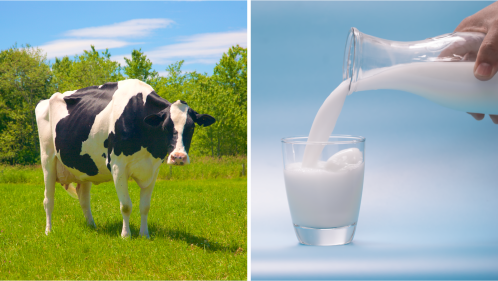Español
Milk is one of the safest foods we can consume in the U.S. today. That wasn’t always the case.
If you look back 100 years, milk was second only to water as a vehicle for transmitting disease, as noted in a 1924 U.S. Public Health Service article.
Back then, people were getting sick or dying from typhoid fever, scarlet fever, tuberculosis, & other illnesses linked to harmful bacteria in milk.
Today it’s a much different story because of pasteurization & other safety measures. For every 2 billion servings of pasteurized milk or milk products consumed in the U.S., only about one person gets sick, according to a U.S. Food & Drug Administration evaluation.
“The improvement in milk safety is an amazing public health accomplishment,” said Jim Jones, Deputy Commissioner for Human Foods at the FDA.
Key to the success is the Standard Milk Ordinance, developed by the U.S. Public Health Service in 1924. “The ordinance laid the foundation for the quality & safety standards we use today to make sure our milk & dairy products are safe,” said Jones.
Marking a Milk Safety Milestone
Pasteurized Milk Ordinance Centennial
Infographic
PDF: 18MB)
Milk Safety Then & Now
Pasteurization is the process of using specifically designed equipment to heat raw milk to a specific temperature for a specific amount of time to kill any harmful bacteria.
In the years leading up to the 1924 Standard Milk Ordinance, pasteurization & other milk safety measures were not consistently applied on farms, in dairy plants, or during transportation.
The ordinance changed that. It promoted safe, quality milk by providing a model milk regulation program — with uniform safety requirements — that states could voluntarily adopt.
Alabama was the first state to do so in 1924. Eventually all 50 states, the District of Columbia & Puerto Rico were on board.
Two decades later, the National Conference on Interstate Milk Shipments (NCIMS) was formed to bring states together to continue developing uniform & effective milk safety programs. Then in 1977, the FDA & NCIMS signed a formal agreement to create the collaborative milk safety program that still exists today.
Milk Safety From the Grass to Your Glass
Beth Briczinski, Ph.D., Senior Science Advisor for Milk Safety at the FDA compares the milk safety program to a three-legged milking stool. The FDA, states, & the dairy industry work together. All the parties help update the ordinance. For products in interstate commerce, the states implement it, & industry must comply with the requirements. The FDA provides additional oversight & uniformity.
The ordinance, with a title that now includes the word pasteurized, applies to pasteurized milk from cows, goats, sheep & other hooved animals.
“We like to say the ordinance covers everything from the grass to the glass. It’s comprehensive,” Briczinski said.
To give you an idea of what that means, here’s some of what the ordinance covers:
- Design of the dairy farm milking areas to prevent contamination.
- Times & temperatures for heating, cooling, transporting & storing milk.
- Design of the milking, processing, & packaging equipment & how it should be controlled, & the testing of milk pasteurization equipment.
- Health & safety requirements for workers.
- Requirements for laboratory testing of raw milk & dairy products for quality & safety.
Updates made over the years reflect the latest science, new processing technologies & new products on the market. An example of the program’s forward thinking is its early adoption of traceability. Since 1963, all milk containers in the U.S. have been required to have a code indicating the state & dairy processing plant where the milk was packaged, so any problems can quickly be traced.
“It’s fair to say that millions of lives have been & continue to be protected because of what began in 1924,” Briczinski said.
Additional Resources
- Pasteurized Milk Ordinance Centennial
- Grade “A” Pasteurized Milk Ordinance, 2019 Revision
- Food Safety & Raw Milk
Source: FDA Consumer Updates

